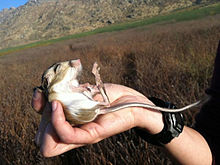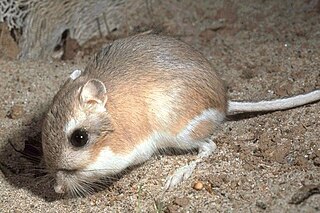
Kangaroo rats, small mostly nocturnal rodents of genus Dipodomys, are native to arid areas of western North America. The common name derives from their bipedal form. They hop in a manner similar to the much larger kangaroo, but developed this mode of locomotion independently, like several other clades of rodents.
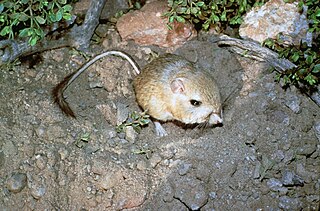
The giant kangaroo rat is an endangered species of heteromyid rodent endemic to California.

Heteromyidae is a family of rodents consisting of kangaroo rats, kangaroo mice, pocket mice and spiny pocket mice. Most heteromyids live in complex burrows within the deserts and grasslands of western North America, though species within the genus Heteromys are also found in forests and their range extends as far south as northern South America. They feed mostly on seeds and other plant parts, which they carry in their fur-lined cheek pouches to their burrows.

A kangaroo mouse is either one of the two species of jumping mouse native to the deserts of the southwestern United States, predominantly found in the state of Nevada. The name "kangaroo mouse" refers to the species' extraordinary jumping ability, as well as its habit of bipedal locomotion. The two species are:

Dipodomyinae is a subfamily of heteromyid rodents, the kangaroo rats and mice. Dipodomyines, as implied by both their common and scientific names, are bipedal; they also jump exceptionally well. Kangaroo rats and mice are native to desert and semidesert ecosystems of western North America from southern Canada to central Mexico. They are generally herbivorous foragers, and dig and live in burrows.
The Texas kangaroo rat is a rodent of the family Heteromyidae. It is found in Texas and Oklahoma in the United States, where it often lives in association with brush species, like mesquite and lotebush, growing in areas with firm clay-loam soils. The species is listed as threatened by the Texas Parks and Wildlife Department and the IUCN lists the species as vulnerable.

Perognathinae is a subfamily of rodents consisting of two genera of pocket mice. Most species live in complex burrows within the deserts and grasslands of western North America, They feed mostly on seeds and other plant parts, which they carry in their fur-lined cheek pouches to their burrows.
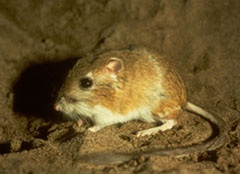
Ord's kangaroo rat is a kangaroo rat native to western North America, specifically the Great Plains and the Great Basin, with its range extending from extreme southern Canada to central Mexico.

The round-tailed ground squirrel, known as "Ardillón cola redonda" in Spanish, live in the desert of the Southwestern United States and Northwestern Mexico. They are called "ground squirrels" because they burrow in loose soil, often under mesquite trees and creosote bushes.

The agile kangaroo rat is a species of rodent in the family Heteromyidae. It is endemic to southern California in the United States.

Heermann's kangaroo rat is a species of rodent in the family Heteromyidae. Their long smooth pelage resembles typical kangaroo rats, with their dorsal side showing a mixed range of olive, black and orange colors. There are 9 distinguished sub-species of Dipodomys heermanni: D.h. arenae, D.h. berkeleyensis, D.h. dixoni, D.h. goldmani, D.h. heermanni, D.h. jolonensis, D.h.morroensis, D.h. swarthi, and D.h. tularensis. The dental formula of Dipodomys heermanni is 1.0.1.31.0.1.3 × 2 = 20.

Merriam's kangaroo rat is a species of rodent in the family Heteromyidae. The species name commemorates Clinton Hart Merriam. It is found in the Upper and Lower Sonoran life zones of the southwestern United States, Baja California, and northern Mexico.
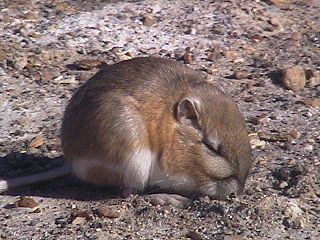
The chisel-toothed kangaroo rat is a species of rodent in the family Heteromyidae.

The Fresno kangaroo rat or San Joaquin kangaroo rat is a species of rodent in the family Heteromyidae. It is endemic to areas within and near the San Joaquin Valley of California in the United States. Habitat destruction due to agricultural development and urbanization has put this species at risk, and the International Union for Conservation of Nature has assessed its conservation status as "vulnerable".

The Panamint kangaroo rat is a species of rodent in the family Heteromyidae. It is endemic to the Mojave Desert in eastern California and western Nevada, in the United States.

Phillips's kangaroo rat is a species of rodent in the family Heteromyidae. It is endemic to Mexico. Its natural habitat is hot deserts.

The banner-tailed kangaroo rat is a species of rodent in the family Heteromyidae. It is found in arid environments in the southwestern United States and Mexico where it lives in a burrow by day and forages for seeds and plant matter by night.
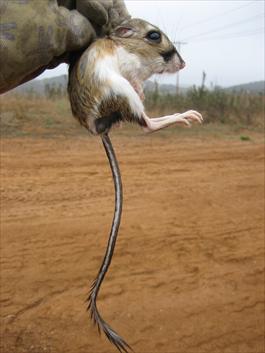
Stephens's kangaroo rat is a species of rodent in the family Heteromyidae. It is endemic to the Southern California region of the United States, primarily in western Riverside County. The species is named after American zoologist Frank Stephens (1849–1937).

The narrow-faced kangaroo rat is a species of rodent in the family Heteromyidae. It is endemic to California in the United States.
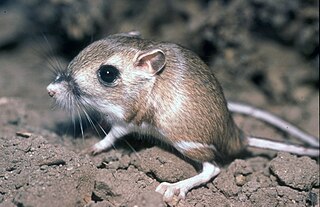
The Tipton kangaroo rat, is a subspecies of the San Joaquin kangaroo rat, a rodent in the family Heteromyidae.
